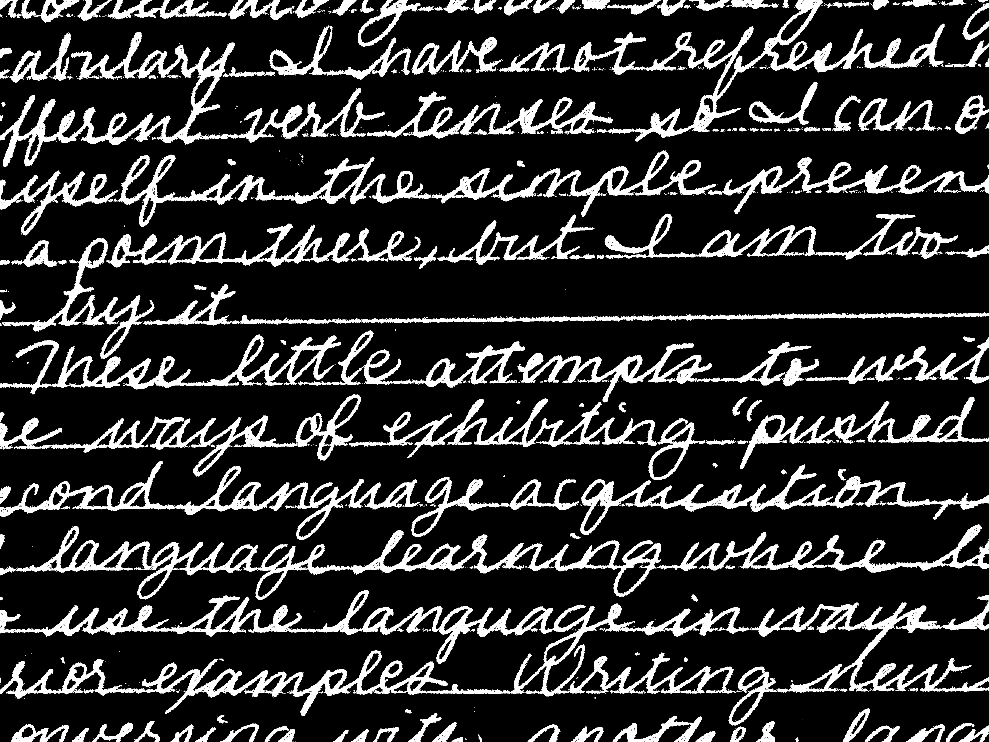Lately, I have been trying to write a few sentences each morning—a paragraph, if we’re being generous—in French to practice reading and writing in the language. My attempts are slow, messy, and probably grammatically incorrect, and my vocabulary couldn’t possibly be more sophisticated than an elementary school child’s vocabulary. I have not refreshed my memory of the different verb tenses and conjugations I learned in high school, so I can only express myself in the present tense.
These little attempts to write in French are ways of practicing “pushed output.” In second language acquisition1 studies, pushed output is the part of the language learning environment where learners try to use the target language in ways it would naturally be used in everyday use, and in ways that deviate from prescribed formulas. Writing new sentences, or conversing with another person in the language to practice speaking extemporaneously—these are examples of pushed output. If you have ever wondered why any language-learning class involves conversation time, it is because instructors are building in time for pushed output.
Of course, these learning concepts are not limited to second language acquisition; it can be useful for anyone to further refine their first language(s). In my own classroom, I encourage pushed output through class discussion, writing prompts, and other activities in which my students are actively working with language and their writing. It’s not enough just to read examples of good writing, but to take it apart and put it together again. It’s not enough to just listen to me point out the structure of an assigned piece, but for my students to get into the heart of the writing themselves.
Lately, I have been having trouble motivating myself to push some output in my first (and so far only) language: English. AWP was a great shot of energy in some ways, but the weeks since then has been somewhat overwhelming, making me really drag my feet through my days. I’ve been a bit sick (’tis the season for mysterious viral illnesses to spread, I suppose) and moving slowly as a result. My creative projects have stalled. My teaching work has been dragging. All this can be explained in part by the underlying fact of my feeling physically unwell. But what about the other parts? The parts that have, in the past, made me feel better because I could write? What happens when I cannot push output?
Five environmental2 elements that “contribute (but do not guarantee) optimal L2 learning are: acculturated attitudes, comprehensible input, negotiated interaction, pushed output, and a capacity, natural or cultivated, to attend to the language code, not just the message.” These are somewhat intuitive: in order to learn a new language, you have to have some kind of affinity for or interest in the language, you have to be exposed to clear messaging in that language, you should interact with people who speak that language, you have to seek opportunities to use the language, and you have to develop a sense for how the language works (its grammar, etc.), not just be able to understand the meanings of communication in that language. My pushed output has stalled; can I find ways to bolster the other elements? How can I cultivate my attitude towards writing? What comprehensible inputs can I (re)visit? Who can I have a negotiated interaction with about writing? How can I keep growing my capacity to attend to the language code?
I don’t have very many answers; lately it feels like I never do. But sometimes I find it useful to pause and think through the ways in which writing falls into these environmental elements of language learning. I forget, sometimes, that I am still learning my first language. I use it so often, and have become immersed in my learning of it, that it has become something like instinct. But it’s not quite instinct. There will always be more to learn. I will always have to maintain a steady practice of learning.
Notes:
- This term is somewhat debated; oftentimes, when people learn another language it can be their third, fourth, fifth, etc., language that they are trying to learn. “Second language acquisition” seems to be a fairly widespread shorthand to communicate the concept of learning a language aside from the first one(s) you learned as a child; “L2” then refers to the “target language,” or the language other than the first that is being learned. The concepts I’ve learned, and the ones I reference in this blog, come from the textbook of the SLA course I took one summer: Second Language Acquisition by Lourdes Ortega, 2013, Routledge.
- Ortega, p. 79. “Environmental” factors don’t refer to the place/ecology, but are a metaphor for the language-learning space.

